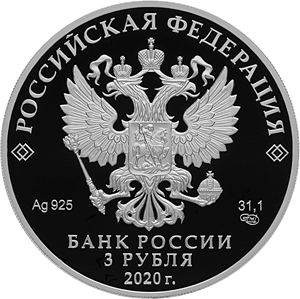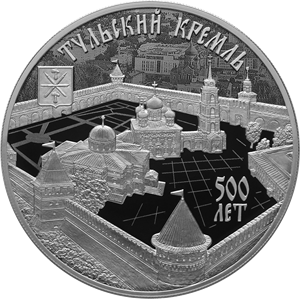500th Anniversary of the Tula Kremlin’s Construction
Obverse
the mirror field of the disc bears a relief image of the National Coat of Arms of the Russian Federation, over it along the rim there is the semicircular inscription ‘РОССИЙСКАЯ ФЕДЕРАЦИЯ’ (RUSSIAN FEDERATION) framed on both sides by doubled rhombuses, below under the coat of arms there are indications of the precious metal and its fineness on the left and the fine metal content and the mint trade mark on the right, at the bottom in the centre, in three lines, there is an inscription ‘БАНК РОССИИ’ (BANK OF RUSSIA), the denomination of the coin ‘3 РУБЛЯ’ (3 RUBLES), and the year of issue ‘2020 г.’ (2020).
Reverse
the mirror field of the disc bears a relief image of the Tula Kremlin against the background of the panoramic view of the city; at the top to the left there is a relief image of the Tula emblem; along the rim there are inscriptions: ‘ТУЛЬСКИЙ КРЕМЛЬ’ (TULA KREMLIN) at the top and two lines ‘500 ЛЕТ’ (500 YEARS) at the bottom to the right.
Authors
Designers: E.V. Kramskaya (obverse), A.D. Schablykin (reverse).
Sculptors: A.A. Dolgopolova (obverse), F.S. Andronov (reverse).
Mint: Saint Petersburg Mint (СПМД).
Edge: 300 corrugations.
Discover more
The Tula Kremlin is an outstanding monument of Russian defenсe architecture of the XVI century. Built on the Muravsky Trail – the most important strategic direction of the Crimean Tatar raids, the Kremlin for several centuries defended the southern borders of the Russian state and was the main link of the famous Great Zasechnaya line. Its history dates back to 1507, when the construction of the ‘stone city’ – the Tula fortress – was started in Tula by the decree of Grand Duke Vasily III. The construction lasted thirteen years and was completed in 1520. During its existence, the Tula Kremlin has never surrendered to the enemy. In 1552, under the walls of the Kremlin, the troops of the Crimean Khan Devlet Giray were defeated, which paved the way for the success of the famous campaign of Tsar Ivan the Terrible against Kazan. In 1607, the rebels led by Ivan Bolotnikov were defending themselves in Tula against the troops of Tsar Vasily Shuisky for more than four months.
The Tula Kremlin is a regular rectangular fortress. The monument’s architecture combines the centuries-old traditions of Russian architecture and the best achievements of Western European fortification art. A distinctive feature of the Tula Kremlin lies in its location in a low place – the floodplain of the Upa River. Active use of fortress artillery in the XVI century made it possible to build citadels in a relatively low place.
Today, the Tula Kremlin is a unique complex of historical and architectural monuments. Its ensemble, besides the walls and towers that have not undergone significant reconstruction since the XVI century, includes two former cathedrals: the Holy Dormition Cathedral (XVIII century) and the Epiphany Cathedral (XIX century), merchant rows (XIX century), and the building of the first city power plant (XX century).
Source: https://тульскийкремль.рф


